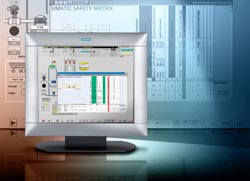

Simatic Safety Matrix is used in the process industry for the engineering and safety lifecycle management of safety functions in accordance with IEC 61511. With the Cause&Effect method, safety functions can be easily created and implemented.
In the new version 6.2 the user can now carry out complex calculations using freely configurable value preprocessing and integrate them in the Safety Matrix. The functions for operation and operator guidance have also been expanded and improved. For instance, in the event of maintenance on a process instrument the operator can now also see the current process values, the simulation values and the currently processed values during simulation and in maintenance override mode.
Another new function is the creation of alarm or matrix displays dependent on cause or effect. The operator is thus guided during operation directly to the information he requires, he then has immediate access to the relevant process information and – if necessary – he is able to intervene quickly. Another new feature of the new version is the free selection of colors for alarms and messages. This option enables easy implementation of customer-specific or regional requirements, i.e. the user can select whatever colors he wants for the alarms and messages.
The Siemens Industry Sector (Erlangen, Germany) is the worldwide leading supplier of environmentally friendly production, transportation, building and lighting technologies. With integrated automation technologies and comprehensive industry-specific solutions, Siemens increases the productivity, efficiency and flexibility of its customers in the fields of industry and infrastructure. The Sector consists of six divisions: Building Technologies, Drive Technologies, Industry Automation, Industry Solutions, Mobility and Osram. With around 207,000 employees worldwide (September 30), Siemens Industry achieved in fiscal year 2009 total sales of approximately €35 billion.
The Siemens Industry Automation Division (Nuremberg, Germany) is a worldwide leader in the fields of automation systems, industrial controls and industrial software. Its portfolio ranges from standard products for the manufacturing and process industries to solutions for whole industrial sectors that encompass the automation of entire automobile production facilities and chemical plants. As a leading software supplier, Industry Automation optimizes the entire value added chain of manufacturers – from product design and development to production, sales and a wide range of maintenance services. With around 39,000 employees worldwide (September 30), Siemens Industry Automation achieved sales of €7.0 billion in fiscal year 2009.
Reference Number: IIA2010042226e












